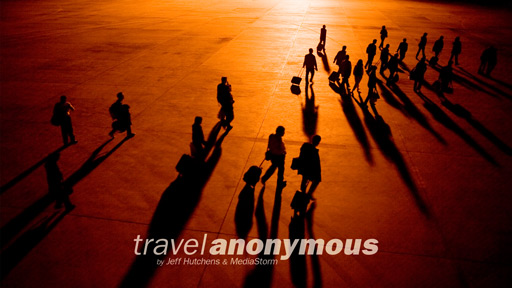I’m a big proponent of working within a set of limitations.
I’ve purposefully done this numerous times both at MediaStorm and in my own work: from setting out to make a film that’s exactly one-minute long to creating a fictional movie with the attributes of a documentary. Setting yourself up against restrictions can be a powerful means of encouraging creative problem solving.
But with Travel Anonymous, a MediaStorm collaboration with photographer Jeff Hutchens, I could literally do anything. Nothing was out of bounds.
Case in point: at one of my first meetings with Jeff, he told me he liked the idea of using only the tiniest portions of his images. A corner here, an interesting blur there. To work without regard to the “sacredness” of a photographer’s pictures felt both exhilarating, and quite honestly, a bit blasphemous.
There was just one objective: to convey what it feels like to travel so much that you lose all sense of time and place. This was to be an immersive, sensory experience.
Early on, though, I was confounded.
Without guidelines or an interview from which to create a narrative, I was, in hindsight, a bit shell-shocked. Yes, I could make a viewer feel disoriented, but then what? How long could that feeling be sustained and would people stick around to watch just ‘confusion’?
My early edits were fancy and a bit indulgent but didn’t serve a larger purpose. No one quite understood what I was trying to do. In short, the approach didn’t work and I was directionless.
I feel a bit silly admitting this now because looking back, my breakthrough seems so stunningly obvious. But here it is: I’d forgotten to tell a story.
I’d been mesmerized by gorgeous photography and stunning visuals– Jeff is a magician that way. But in my enchantment, I’d neglected my primary responsibility: to take those watching on a journey. To start one place and end in another.
So I set to work, creating a structure that would support such a voyage. That trip, the one I hope you will now take, is not guided by narration like so much of our other work, but it is, at heart, a very traditional journey nonetheless. [1]
So this is what I learn time and again: most audiences have a limited tolerance for spectacle. All of us long for something deeper, to watch others face obstacles, to be challenged and to overcome. We want to be reminded of what it feels like to be human. Story is that tool and it will see you through.
Just as it did for me.
-
Kurt Vonnegut once slyly remarked that there are really only two kinds of stories. The first is what happens when a stranger comes to town. In the second, a hero goes on a journey. Travel Anonymous very much falls into the latter camp. ↩


